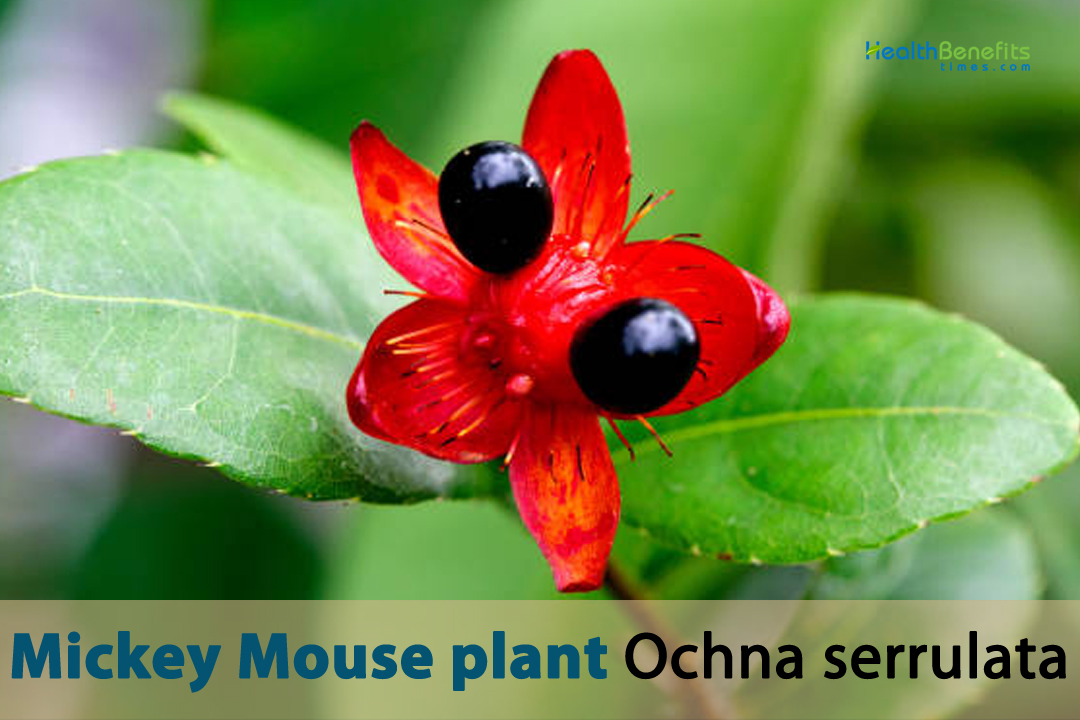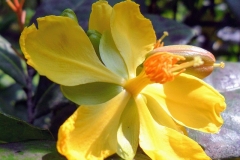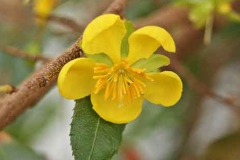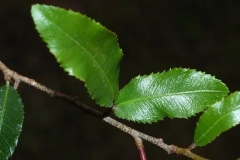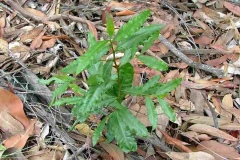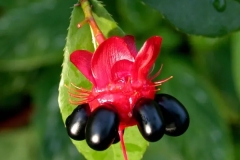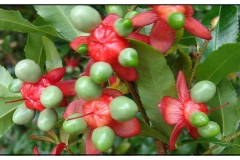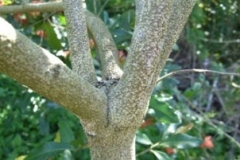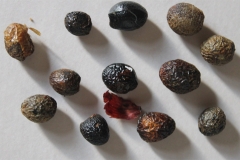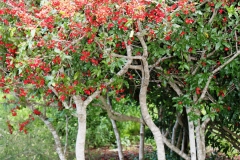| Mickey Mouse plant Quick Facts | |
|---|---|
| Name: | Mickey Mouse plant |
| Scientific Name: | Ochna serrulata |
| Origin | Various regions in Africa, including parts of southern Africa (i.e. South Africa, Lesotho and Swaziland) |
| Colors | Initially green turning to black as they mature |
| Shapes | Small and round, typically measuring around 1 to 1.5 centimeters (0.4 to 0.6 inches) in diameter |
| Major nutrients | • Phytochemicals • Fiber • Vitamins and Minerals |
| Health benefits | Immune System Support, Stress Relief, Wound Healing, Gastrointestinal Health, Fever Reduction, Diabetes Management, Skin Health, Respiratory Health and Pain Relief |
| Name | Mickey Mouse plant |
|---|---|
| Scientific Name | Ochna serrulata |
| Native | Various regions in Africa, including parts of southern Africa (i.e. South Africa, Lesotho and Swaziland). It has also been introduced and cultivated in other warm climates around the world. It is considered an invasive weed in some parts of Australia and New Zealand |
| Common Names | Bird’s Eye Bush, Carnival Bush, Small-leaved Plane, Rambling Yellow Bell, Red Orchid Tree, Peela Kaner, Mickey Mouse Bush, Mickey Mouse Tree, Mickey Mouse Yellow Bell, Mickey Mouse Flower, Chinese Golden Flower, Yellow Flame Tree, Mickey Mouse Wood, Bird’s Eye Ochna, Mickey Mouse Fruit, Red Mickey Mouse Plant, Yellow Mickey Mouse Tree |
| Name in Other Languages | Afrikaans: Mickey Mouse-plant, Kleinblaar rooihout, Fynblaarrooihout Albanian: Bimë e Miqkut Mause Amharic: Be Miki Mot (በሚኪ ሞት), Balabeti Miki Moron (ባለቤት ሚኪ ሞሮን) Angika: Mikī Mā’aus Phūlvālā Gūc (मिकी माउस फूलवाला गूच) Arabic: Nabat Miki Maus (نبات ميكي ماوس), Nabat Miki Maus Al-Adhn (نبات ميكي ماوس الأذن) Armenian: Miki Mausi buyus (Միքի Մաուսի բույս) Assamese: Miki Maus Gach (মিকি মাউস গাছ) Azerbaijani: Mikki Maus bitkisi Basque: Mickey Mouse Lorea Bengali: Miki Maus Gachh (মিকি মাউস গাছ) Bodo: Mikī Mā’ūs Banj (मिकी माउस बंज) Bosnian: Biljka Miško Miki Catalan: Planta del Ratolí Mickey Chinese: Mǐqí Lǎoshǔ Zhíwù (米奇老鼠植物), Shǔ yǎn mù (鼠眼木) Croatian: Biljka Miško Miki, Mikimaus biljka Czech: Mickey Mouse rostlina, Rostlina Mickey Mouse Danish: Mickey Mouse-plante Dogri: Mikī Mā’ūs Poudha (مکی ماؤس پودھا) Dutch: Mickey Mouse plant, Bloeiende Minnie Mouse Struik English: Mickey Mouse-plant, Carnival Redwood, Bird’s Eye Bush, Carnival Ochna, Mall-leaved Plane, Mickey Mouse Bush, Small-leaved plane, carnival bush, Mickey Mouse tree, small-leaved plane, ochna Estonian: Miki-Hiire taim Filipino: Halamang Mickey Mouse Finnish: Mikki Hiiri –kasvi, Kiiltomikinpensas French: Plante Mickey Mouse, arbre de Mickey Galician: Planta Mickey Mouse Garo: Mickey Mouse Plant Georgian: Miki Mausis mtzenare (მიკი მაუსის მცენარე), Miki Mausis Mcenare (მიკი მაუსის მცენარე) German: Mickey-Maus-Pflanze, Sägeblättrige Nagelbeere, Mickymausbusch, Ochna Greek: Fytó tou Míky Máous (Φυτό του Μίκυ Μάους) Gujarati: Mikī Mā’usa Plānt (મિકી માઉસ પ્લાન્ટ) Haitian Creole: Plant Mickey Mouse Haryanvi: Mikī Mā’aus Gūṛā (मिकी माउस गूंड़ा) Hausa: Mickey Mouse shuka Hawaiian: Lāʻau Mickey Mouse Hebrew: Tzemach Miki Ma’us (צמח מיקי מאוס) Hindi: Miki Maus Paudha (मिकी माउस पौधा), Miki Maus Ke Kaan Ka Paudha (मिकी माउस के कान का पौधा) Hungarian: Mickey egér növény, Mickey Mouse növény Icelandic: Músarplanta Igbo: Nchịkọta Mickey Mouse, Okwe Mickey Mouse Indonesian: Tanaman Mickey Mouse Irish: Planda Mickey Mouse Italian: Pianta di Topolino, Fiore d’orecchie di topo Japanese: Mikkī Mausu Shokubutsu (ミッキーマウス植物), Mikkī Mausu no Shokubutsu (ミッキーマウスの植物), Mikkī Mausu Iyā Puranto (ミッキーマウスイヤープラント) Kannada: Mikki Maus Gida (ಮಿಕ್ಕಿ ಮೌಸ್ ಗಿಡ) Kashmiri: Mikī Mā’ūs Baz (مکی ماؤس بذ) Kazakh: Mikki Maus ösimdigi (Микки Маус өсімдігі), Mikki Maus jemisi (Микки Маус жемісі) Khasi: Mikī Mā’ūs Khūb (मिकी माउस खूब) Kokborok: Mickey Mouse Yaba Konkani: Mikī Mā’aus Jhāḍ (मिकी माउस झाड) Korean: Miki Mauseu Sikmul (미키 마우스 식물), Miki Mauseu Gwi Sikmul (미키 마우스 귀 식물) Kurukh: Mikī Mā’ūs Phūlvāl Gaharī (मिकी माउस फूलवाल गहरी) Kyrgyz: Mikki Maus kökönök (Микки Маус көкөнөк), Mikki Maus kündölögü (Микки Маус күндөлөгү) Lithuanian: Miškinukas peliukas augalas Latvian: Miki Peles Auglis Macedonian: Rastenie Miško Miki (Растение Мишко Мики) Maithili: Mikī Mā’ūs Vanaspati (मिकी माउस वनस्पति) Malagasy: Hazo Mickey Mouse Malay: Tumbuhan Mickey Mouse Malayalam: Mikki Maus Plant (മിക്കി മൗസ് പ്ലാന്റ്) Manipuri: Miki Maus Puṣpa (মিকি মাউস পুষ্প) Marathi: Mikī Mā’ūs Vanaspati (मिकी माउस वनस्पती) Maltese: Pjanta tal-Mickey Mouse Malto: Mikī Mā’aus Kokaṇ (मिकी माउस कोकण) Mizo: Mickey Mouse Thlan Mongolian: Mikki Maus öndög (Микки Маус өндөг) Nepali: Miki Maus Biruwā (मिकि माउस बिरुवा), Miki Mā’us Plānt (मिकि माउस प्लान्ट) Norwegian: Mikke Mus-plante Occitan: Planta Mickey Mouse Odia: Miki Mausa Br̥kṣa (ମିକି ମାଉସ ବୃକ୍ଷ) Persian: Giyāh-e Miki Moos (گیاه میکی موس) Polish: Roślina Myszka Miki Portuguese: Planta Mickey Mouse, Arbusto Floral da Minnie Mouse, arbusto-olho-de-pássaro, mickey, ocna Punjabi: Mikki Maus Pauda (ਮਿੱਕੀ ਮਾਊਸ ਪੌਦਾ) Romanian: Plantă Mickey Mouse Russian: Rastenie Mikki Mausa (Растение Микки Мауса), Tsvetushchiy kust Minni Maus (Цветущий куст Минни Маус), Mikki Maus (Микки Маус), ptich’i glazki (птичьи глазки) Sanskrit: Mikī Mā’ūs Vanaspati (मिकी माउस वनस्पति) Santali: Miki Mawus Chando (ᱢᱟᱦᱟᱨ ᱨᱮᱛᱷᱤ) Scottish Gaelic: Lus Mickey Mouse Serbian: Biljka Miško Miki (Биљка Мишко Мики) Sindhi: Mikī Mā’ūs Plaṇṭ (مڪي مائوس پلنٽ) Sinhala: Mikki Mawus Pālwum (මික්කි මවුස් පැළවුම), Mikki Mawus Wagaawa (මික්කි මවුස් වගාව) Slovak: Rastlina Mickey Mouse Slovenian: Rastlina Miška Miki Somali: Beerka Mickey Mouse Spanish: Planta de Mickey Mouse, Orejas de Ratón, Planta-do-rato-mickey, ochna Swahili: Mmea wa Mickey Mouse, Sifubasenkhala Swedish: Musse Pigg-växt, Mickey Mouse växt, Mussepiggbuske Tajik: Rūi Mikki Maus (Рӯи Микки Маус), Gulshni Mikki Maus (Гулшни Микки Маус), Rūyhati Mikki Maus (Рӯйхати Микки Маус) Tamil: Mikki Mavus Paḻam (மிக்கி மவுஸ் பழம்) Telugu: Mikkī Maus Plānt (మిక్కీ మౌస్ ప్లాంట్) Thai: Phuea Chīk Mikkī Maw (พืชมิกกี้เมาส์), Tôn Maikii Meāws (ต้นไมค์กี้เมาส์) Turkish: Mickey Mouse bitkisi Ukrainian: Roslyna Mikki Mausa (Рослина Міккі Мауса) Urdu: Miki Maus Poda (مکی ماؤس پودا) Uzbek: Mikki Maus oʻsimlik Vietnamese: Cây Mickey Mouse, Mai tứ quý Welsh: Blodyn Mickey Mouse Xhosa: Iqunube le-Mickey Mouse Yoruba: Ewe Mickey Mouse, Egbo Mickey Mouse Zambia: Munyelenyele Zulu: Isitshalo se-Mickey Mouse, Umbomvane, Umbovu |
| Plant Growth Habit | Beautiful, small to medium-sized evergreen, semi-deciduous, ornamental shrub |
| Growing Climates | Dry sclerophyll forest, roadsides, disturbed sites, waste areas, rainforests, forest margins, riparian areas, sand plains, heathland, open forest, grassland and rock walls |
| Soil | Well-draining, rich soil that retains some moisture without becoming waterlogged |
| Plant Size | Between 1 and 2 m (3.3 and 6.6 ft) high, although it may occasionally become a small tree up to 6 m (20 ft) high |
| Root | Consists of several main types of roots, including taproots and lateral roots. The taproot is the primary root that grows directly downward from the plant’s base, while lateral roots branch out horizontally from the taproot |
| Stem | Woody and erect, growing upward from the base of the plant. It features a central trunk that gives rise to branches and leaves. The stems are covered with small, raised, light-coloured dots, known as lenticels |
| Bark | Younger stems tend to have smoother bark, while older stems develop rougher and more textured bark. The color of the bark can range from grayish-brown to darker shades of brown |
| Leaf | Narrow leaves are oblong to elliptic and measure 30–60 mm (1.2–2.4 in) in length by 8–15 mm (3⁄8–5⁄8 in) wide, and are shiny green with fine toothed serrations along the leaf edges |
| Flowering season | September to November |
| Flower | Small, yellow, and star-shaped. Each flower typically has five petals that radiate outward from a central point, resembling the ears of Mickey Mouse, which is how the plant earned its common name. The size of the flowers can vary, but they are generally around 1 to 2 inches (2.5 to 5 cm) in diameter |
| Fruit Shape & Size | Small and round, typically measuring around 1 to 1.5 centimeters (0.4 to 0.6 inches) in diameter. They consist of two distinct parts: a bright red seed capsule and two black seeds |
| Fruit Color | Initially green turning to black as they mature |
| Seed | Small and black, resembling the “ears” of the cartoon character Mickey Mouse. They are typically oval or slightly teardrop-shaped and have a smooth, shiny surface |
| Flavor/Aroma | Might not have a notable aroma |
| Plant Parts Used | Bark, roots, fruit, leaves |
| Propagation | By seeds, stem cuttings, Layering, Division |
| Lifespan | For 20 years or more |
| Varieties |
|
| Season | Around May to July |
| Major Nutrition |
|
| Health benefits |
|
Plant Description
The Mickey Mouse plant is a small to medium-sized evergreen, semi-deciduous, ornamental bush that usually grows between 1-3 m (3.3-6.6 ft) high, but it can sometimes grow up to 6 m (20 ft) high and become a small tree. The plant grows in dry sclerophyll forest, along roadsides, in disturbed areas, in waste areas, in rainforests, on the edges of forests, along rivers, in sand fields, heathland, open forest, grassland, and on rock walls. The plant does best in rich soil that drains well and holds some water without getting too wet. A good combination is potting soil, peat moss, and perlite or sand. Even though the Mickey Mouse plant looks nice, it’s important to know that some Ochna species’ berries are poisonous if eaten, so be careful, especially if you have pets or small children. Because it looks different from other plants, it is used as an ornamental plant in parks and other landscapes. For the Vietnamese New Year, the Ochna is a sign of happiness.
Appropriate growing environments of Mickey Mouse plant
The Mickey Mouse plant is a unique and attractive plant known for its distinctive red and black berries that resemble the iconic cartoon character’s face. To provide an appropriate growing environment for the Mickey Mouse plant, consider the following guidelines:
- Climate and Hardiness: The Mickey Mouse plant is native to warm and subtropical areas. It does well in warm places and can be grown in USDA hardiness zones 9 to 11. It might be able to live in slightly cooler areas if it is taken care of and kept warm during the winter.
- Sunlight: Give the plant bright light from the side. It can handle some straight sunlight, but if it gets too much, its leaves will get burned. If you’re growing it inside, put it near a window that lets in light that has been screened.
- Temperature: Give the Mickey Mouse plant a warm place to live. It likes days that are between 65°F and 85°F (18°C and 29°C) and nights that don’t get below 50°F (10°C).
- Humidity: This plant likes it when the air is wet. If you live in a dry area or are growing indoors, you can increase humidity by using a fan or putting a tray of water near the plant.
- Soil: Use thick soil that drains well and holds some water without getting soggy. A good combination is potting soil, peat moss, and perlite or sand.
- Watering: When the top inch of dirt feels a little dry to the touch, water the Mickey Mouse plant. It’s important not to water too much because that can cause root rot. Make sure the pot has holes in the bottom to keep water from pooling there.
- Fertilization: During the plant’s growth season (spring and summer), feed it every 4 to 6 weeks with a balanced liquid fertilizer. When growth slows down in the winter, cut back on or stop watering.
- Pruning: Make sure to prune the plant often so it keeps its shape and grows in a healthy way. Take off any leaves that are dead, dying, or turning yellow.
- Container Growing: If you want to grow the Mickey Mouse plant indoors or in a colder environment, you can do so in a pot that can be brought inside during the winter. Choose a pot with good drainage and take good care of the plant to keep it from getting stressed out during changes.
- Propagation: The Mickey Mouse plant can be grown from seeds or by cutting off pieces of the stem. If you’re growing plants from cuttings, make sure they have a node and put them in a rooted medium that drains well.
History
The plant is from South Africa, where it grows in the forests. It can be found all over the country, from Cape Town in the south to Kwazulu-Natal on the east coast and from Eswatini to Gauteng in the center. This hardy shrub can grow in warm, open areas or in the shade of a dense forest.
It has been grown as an ornamental plant outside of South Africa, and it is now a weed in New South Wales and southern Queensland in eastern Australia, where it is found near people’s homes in and around big towns and cities.
Roots
There are two main kinds of roots in a plant’s root system: taproots and branching roots. The taproot is the main root that comes straight down from the plant’s base. Lateral roots grow out from the taproot in a horizontal direction. These side roots grow in different ways to hold the plant down in the soil and take in water and nutrients. The plant’s roots act as its anchor and help keep it steady in the dirt. This steadiness is important, especially when the weather is windy or bad, and it also helps the plant grow and develop above ground. Roots can also store nutrients and sugars made by the plant during photosynthesis. These saved nutrients can be used for growth, flowering, or fruiting, or when there aren’t enough nutrients from the outside.
Stem
Stem is straight and woody. It grows up from the plant’s base. It has a stem in the middle that grows branches and leaves. The plant’s leaves and flowers grow toward the sun because of how the stem grows. Bark covers the outside of the stem and protects it from things like losing water and getting hurt by the environment. The bark can be different in texture and color, which adds to the plant’s beauty. From the main root, the stem sends out branches that grow in different directions. These stems grow leaves, flowers, and sometimes seeds or fruits, which add to the shape of the plant as a whole.
Vascular cells in the stem are in charge of moving water, food, and other important things throughout the plant. Xylem tubes carry water and minerals through the roots to the leaves, while phloem tubes carry out sugars and other products of photosynthesis from leaves to other parts of plant. It’s important to trim and take care of the stem in the right way for the plant’s health. By cutting back a plant, you can make it grow more leaves and flowers and keep it in a good shape.
Bark
Bark can look and feel different based on the age and growth of the plant. The bark on younger stems is usually smoother, while the bark on older stems gets rougher and more wrinkled. The bark can be any shade of brown, from greyish brown to darker brown. This color can change with age, time in the sun, and different kinds of weather. The bark’s main job is to guard the stem and branch tissues underneath. It protects against bodily damage, disease-causing germs, pests, and harsh weather.
The bark also helps control how much water is in the plant. It stops the stem from losing water through a process called transpiration, in which water vapor leaves the bark pores. Bark works as insulation and helps keep the plant’s inner tissues at the right temperature. It acts as a cushion against sudden changes in temperature and extremes.
Leaves
Leaves are simple, which means that each leaf has only one blade. They alternate along the stems, with one leaf coming out of each node. The shape of the leaves ranges from oval to elliptical, and the sides are cut or have teeth. The species name “serrulata,” which means “finely toothed,” comes from the small, sharp teeth on the ends of the leaves. The size of a leaf can change, but most leaves are a few inches long. The size can be affected by things like the age of the plant, the environments in which it grows, and genetic differences.
The tops of leaves are usually shiny and dark green, while the bottoms are usually lighter green. This difference in colors makes the leaves look better. The leaves have large veins that spread out from the middle of the leaf to the ends. Venation gives the leaf more skeletal support and helps move water and nutrients. Photosynthesis is the process by which plants turn energy from the sun into fuel for their growth and development. Photosynthesis can’t happen without leaves. This is done by the green pigment chlorophyll, which is found in the plants. Leaves also make it easier for gases to move between the plant and the air. This lets the plant take in carbon dioxide for photosynthesis and give off oxygen as a result of the process.
Flowers
The flowers are tiny, yellow, and in the shape of a star. The popular name for this plant comes from the fact that each flower has five petals that spread out from a central point like Mickey Mouse’s ears. The flowers can be different sizes, but most are about 1 to 2 inches (2.5 to 5 cm) across. The bright yellow color of the petals stands out against the green background of the leaves. The flowers grow in groups, called inflorescences, at the end of each branch. These clusters can be made up of several different flowers grouped together to make a striking show. Most of the time, the plant blooms during the warm months, with the most flowers in spring and summer. The exact time can change depending on things like the weather and how the plants are growing.
Insects, especially bees, butterflies, and other pollinators, spread pollen from flower to flower. These insects are drawn to the bright colors and sweet smells of the flowers, which makes it easier for pollen to move from one flower to another and helps the flowers reproduce. Flowers are the parts of a plant that reproduce. Each flower has male stamens that make pollen and a female pistil in the middle that holds the ovary. Pollination causes the ovules in the ovary to become fertilized, which causes seeds to form.
Fruits
The fruits are small and round, and usually measure between 0.4 and 0.6 inches (or 1 to 1.5 centimetres) across. They have a bright red seed shell and two black seeds that are separate parts. The plant’s common name comes from the fact that it looks like the well-known cartoon figure Mickey Mouse. The red seed shell is the “face” of Mickey Mouse, and the two large black seeds are his “ears.” The red color of the seed pod makes the fruit stand out from the green leaves of the plant. This bright color makes the plant more attractive as a decorative species.
Seeds
The seeds are small and black, like the “ears” of the cartoon figure Mickey Mouse. Most of the time, they are oval or slightly teardrop-shaped, and the outside is smooth and shiny. The seeds are usually between 5 and 8 millimeters long, based on the plant and the conditions in which it grows. The Mickey Mouse plant’s red seed pods, which are the fruit, are where the seeds grow. The two black seeds inside each seed capsule are at the bottom of the shell.
The seeds of the Mickey Mouse plant can grow into new plants if the conditions are right. When a seed germinates, it takes in water, which softens its top shell and starts the growth of a new plant. Important factors that affect germination include the right amount of water, temperature, and conditions in the dirt.
Varieties of Mickey Mouse plant
Mickey Mouse plant offer slight variations in appearance and growth characteristics. Please note that plant varieties and cultivars may evolve over time, so it’s a good idea to consult with local nurseries or horticultural references for the most up-to-date information. Here are a couple of notable varieties:
- Ochna serrulata ‘Dwarf’: This type of Mickey Mouse plant is known for being smaller than the standard Mickey Mouse plant. Most of the time, the ‘Dwarf’ type grows more compactly and has shorter stems. It could be a good option for smaller gardening or pots.
- Ochna serrulata ‘Golden Flower’: This variety is known for its yellow-gold flowers, which are different from the yellow flowers that are more common on the wild Mickey Mouse plant. The yellow color makes the plant look different and interesting.
- Ochna serrulata ‘Alba’: The ‘Alba’ type is different because its flowers are white instead of yellow. Compared to the standard Ochna serrulata, which has yellow flowers; this version has a different and more beautiful look.
- Ochna serrulata ‘Pink Flowers’: This variety, as its name suggests, has pink flowers instead of the usual yellow ones. Different kinds with pink flowers can add a splash of color to your yard.
- Ochna serrulata ‘Ruby Red’: This variety is known for its flowers, which are deep red or pinkish-red and stand out against the green leaves. The bright colors of the flowers make the plant look bold and interesting.
- Ochna serrulata ‘Fireworks’: This type gets its name from the bright red and yellow flowers that look like fireworks. When red and yellow petals come together, they make a beautiful show.
- Ochna serrulata ‘Copper Tips’: This variety has yellow flowers with coppery-red tips that make them stand out from other yellow flowers. The small changes in color give the plant depth and interest.
- Ochna serrulata ‘Variegata’: The ‘Variegata’ type stands out because its leaves are green and white or cream-colored in different places. This makes the plant look better even when it doesn’t have flowers.
- Ochna serrulata ‘Yellow Bell’: This type of plant is known for its yellow flowers that look like bells. It’s different from a regular Mickey Mouse plant because its flowers are in the shape of a star, while most Mickey Mouse plants have round flowers.
- Ochna serrulata ‘Double Flower’: As the name suggests, this type has flowers with two petals. This makes the flowers look fuller and more intricate. When the petals are doubled, it can look charming and sweet.
- Ochna serrulata ‘Compacta’: The ‘Compacta’ variety is chosen because it grows more slowly and can be grown in smaller areas or in containers. It has a small size but still has the famous Mickey Mouse fruit and flower designs.
- Ochna serrulata ‘Apricot’: This variety is known for its apricot or peach-colored flowers, which give the garden a warm and inviting, color. The unique color gives the scenery a touch of warmth.
- Ochna serrulata ‘Red Ears’: The “ears” of Mickey Mouse can be seen in the dark red seed capsules of this type. The green leaves really stand out against the bright red color.
- Ochna serrulata ‘Orange Blaze’: As the name suggests, this cultivar has bright orange flowers that stand out in the yard and make a statement.
- Ochna serrulata ‘Lutea’: The ‘Lutea’ type is known for its flowers that are light yellow or creamy yellow. The lighter colors give off a soft and soothing vibe.
Mickey Mouse plant Image Gallery
Health benefits of Mickey Mouse plant
Mickey Mouse plant is a unique and charming plant that is often recognized for its distinctive bright red seed pods that resemble the iconic ears of Mickey Mouse. While it’s primarily grown as an ornamental plant, it also offers some potential health and wellness benefits. Here is some potential health benefits associated with the Mickey Mouse plant
1. Antioxidant Properties
Some of the compounds in the plant have anti-oxidant effects. Antioxidants help keep dangerous molecules called free radicals from hurting the body’s cells. Antioxidants may improve general health and well-being by getting rid of these free radicals.
2. Anti-Inflammatory Effects
Some people say that the Mickey Mouse plant might help with pain and inflammation. Less inflammation is linked to a lower chance of chronic diseases and can help with comfort and well-being in general.
3. Immune System Support
There may be compounds in the plant that help the defense system. A healthy immune system is very important for protecting the body from infections and diseases.
4. Astringent Properties
Astringents are chemicals that can make tissues tighter and stronger. The astringent qualities of the plant have been used in some traditional ways to treat skin problems and small wounds.
5. Stress Relief
As an attractive plant with a unique look, the Mickey Mouse plant can be good for your mental health by giving you pleasure from the way it looks. Getting involved with plants and outdoors has been shown to help people relax and feel less stressed.
6. Wound Healing
In some countries, the Mickey Mouse plant is used to help wounds or cuts heal by putting extracts or other preparations on the wound or cut. This could be because it could kill bacteria and reduce inflammation.
7. Gastrointestinal Health
In traditional medicine, the Mickey Mouse plant has been used to treat stomach problems. It is thought to have mild laxative effects that could help people who are constipated. But there isn’t much evidence from science to back up this theory.
8. Fever Reduction
Some parts of the Mickey Mouse plant have been used to treat fever in traditional medicine. But more study is needed to figure out how this possible effect works and if it is safe.
9. Diabetes Management
Diabetes is treated in some traditional ways with Mickey Mouse plant. It is thought to have qualities that could help control how much sugar is in the blood. Still, scientific research is needed to find out if it works and is safe for this reason.
10. Skin Health
Some traditional remedies for skin problems have used extracts from the Mickey Mouse plant on the face. Possible antibacterial and anti-inflammatory qualities of the plant could help treat minor skin problems.
11. Respiratory Health
In some old ways of doing things, the Mickey Mouse plant has been used to help with breathing problems. People think that some of the plant’s chemicals might have calming or respiratory-supporting effects. But this claim needs to be backed up by more study.
12. Pain Relief
The Mickey Mouse plant has been used for a long time to ease small pains and discomforts. This could be because it might have anti-inflammatory properties, but there isn’t enough scientific proof to say for sure.
Culinary uses of Mickey Mouse plant
Mickey Mouse plant is primarily considered an ornamental plant due to its unique appearance, and there is limited information available regarding its culinary uses.
- Edible Flowers for Garnish: The Mickey Mouse plant has bright yellow flowers that could be used as a garnish for different meals. Flowers that you can eat are often used to add color and beauty to salads, sweets, and other foods.
- Candied Flowers: Candies can be made from edible flowers, like those from the Mickey Mouse plant, and used to decorate cakes, cupcakes, and other baked goods. This is done by putting a thin layer of sugar syrup on the flowers and letting them dry. This makes a crunchy and sweet decoration.
- Floral Infusions: Some times, drinks like water, vinegar, or oils are flavored with flowers that can be eaten. You could try putting the flowers of the Mickey Mouse plant into vinegar or oil to give it a unique flavor or to use it as an aromatic ingredient in food.
- Herbal Teas: Even though the Mickey Mouse plant is not usually used to make herbal teas, some flowers that are safe to eat are used to make herbal drinks that smell nice and taste good. Before you try to make tea from the plant’s flowers, you should find out if they are safe and how they taste.
- Ethnic Cuisine Exploration: If the Mickey Mouse plant has been used in food in certain parts of the world for a long time, learning about international cuisines could help you figure out how it could be used. Some cultures add flowers and other unusual parts of plants to their food for taste, smell, and cultural reasons.
Different uses of Mickey Mouse plant
The term “Mickey Mouse plant” is commonly used to refer to several different plants that have leaves with a distinctive shape resembling the silhouette of Mickey Mouse’s head, including his ears. Listed below are different uses of Mickey Mouse plant
- Ornamental Plant: Because of the shape of its leaves, the Mickey Mouse plant is often grown as a beautiful plant in gardens and parks. It gives outdoor spaces a bit of fun and can be used as a focal point or to start a talk.
- Decorative Indoor Plant: Some types of plants with Mickey Mouse-shaped leaves can also be grown as pets for decoration. Their unique leaves can add a fun and interesting touch to indoor design.
- Educational Purposes: Plants that look like Mickey Mouse can be used to teach, especially in schools, nature centers, and botanical parks. They are a fun way to teach guests, students, and kids about the different kinds of plants and how leaves look.
- Symbolism and Culture: Plants like the Mickey Mouse plant may have cultural or symbolic meaning in some countries. They could be used in traditions, ceremonies, or parties as a way to show how beautiful and varied nature is.
- Conservation: Some Mickey Mouse plants might be native to certain areas and could be important to the environments of those places. In order to keep biodiversity, conservation efforts may focus on saving and keeping these plants.
- Botanical Interest and Research: Botanists and experts might look at plants with unique leaf shapes like the Mickey Mouse plant to learn more about how leaves grow, how genes work, and how they have changed over time.
- Photography and Art: Mickey Mouse plants have leaves that have a shape that makes them stand out. This makes them a popular subject for photographers and artists who want to show the beauty and uniqueness of nature.
- Landscaping and Topiary: Skilled gardeners and landscapers might use Mickey Mouse plants as part of bigger design ideas, such as topiaries or themed gardens, to make outdoor spaces that are visually appealing and fun.
- Plant Collecting and Enthusiast Culture: The Mickey Mouse plant’s leaves might draw plant collectors and fans because they are different. This could add variety to their collections and make fans feel closer to each other.
Side effects of Mickey Mouse plant
It’s important to clarify that “Mickey Mouse plant” can refer to various plant species with similar leaf shapes, and each specific species may have its own unique characteristics and potential effects. However, here are some general considerations and potential side effects that could be associated with plants resembling the Mickey Mouse plant:
- Allergic Reactions: Some people may be allergic to certain types of plants, which could cause skin irritation, redness, itching, or allergy dermatitis if they touch the leaves or sap of those plants.
- Toxicity: Depending on the species, the leaves, stems, or berries of a plant might have chemicals that are poisonous. If these poisonous parts are eaten or touched, they could cause stomach pain, nausea, vomiting, or even more serious symptoms.
- Skin Irritation: If the plant’s sap includes substances that can irritate the skin or mucous membranes, handling those plants could make your skin itch.
- Eye Irritation: If you get plant sap near your eyes by accident, it could cause itching, redness, and pain.
- Respiratory Issues: People who are sensitive to allergens may have trouble breathing when pollen or other plant bits are in the air.
- Digestive Upset: Some parts of some plants, if eaten, could cause stomach pain, sickness, vomiting, or diarrhea.
- Unwanted Spread: If they aren’t taken care of properly, some plant species could become invasive and spread quickly, which could upset local environments and push out native plants.
- Environmental Impact: Large-scale farming of non-native or invasive plant species could have an effect on the local environment and biodiversity.
- Misidentification: If someone thought the Mickey Mouse plant was a poisonous plant, they might accidentally eat or touch it, which would be bad.
References:
https://www.itis.gov/servlet/SingleRpt/SingleRpt?search_topic=TSN&search_value=565325#null
http://www.hear.org/pier/species/ochna_serrulata.htm
https://www.cabidigitallibrary.org/doi/10.1079/cabicompendium.115838
https://www.missouribotanicalgarden.org/PlantFinder/PlantFinderDetails.aspx?taxonid=282925
http://www.stuartxchange.com/MickeyMouseBush
http://www.theplantlist.org/tpl1.1/record/tro-22800419
https://en.wikipedia.org/wiki/Ochna_serrulata
https://gd.eppo.int/taxon/OCNSE
https://www.wikidata.org/wiki/Q568648
https://www.scientificlib.com/en/Biology/Plants/Magnoliophyta/OchnaSerrulata01.html
https://pza.sanbi.org/ochna-serrulata
https://plants.usda.gov/home/plantProfile?symbol=OCSE2


